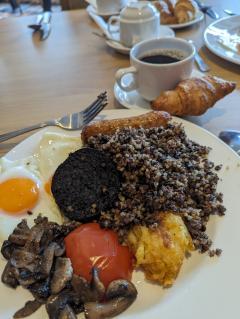 We left Fort William after breakfast and went directly to Edinburgh, with just a few minor stops along the way. Because we had arrived at the hotel so late, we were getting a later start and Edinburgh has too much to compress.
We left Fort William after breakfast and went directly to Edinburgh, with just a few minor stops along the way. Because we had arrived at the hotel so late, we were getting a later start and Edinburgh has too much to compress.
The breakfast at the hotel was a buffet of indifferent quality, but I was happy to see that, in addition to the usual black pudding and Cumberland sausage, I could have a hearty helping of haggis! Haggis for breakfast was another new foodie experience, although perhaps not one that everyone would enjoy as well as I did. In Ireland you can get the Full Irish Breakfast, and in England (and aboard the Queen Mary 2) you can get the Full English Breakfast, so I guess this would the the Full Scottish Breakfast. In any event it was certainly sufficient fuel to start our next full day of adventuring.
It's a three-hour drive to Edinburgh, through some pretty fine scenery, so we made one stop along the way to admire a large dam with a nice lake that was made more appealing by the presence of clean rest rooms.
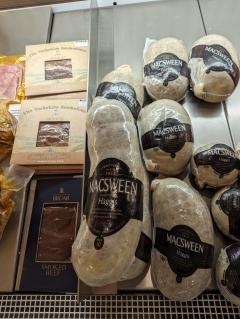 We made one other stop, at a sprawling retail complex called The House of Bruar, about an hour and a half north of Edinburgh. It had clothing, housewares, gifts, liquor, and a huge gourmet market that I just had to investigate. Among many treats I saw MacSween brand authentic frozen haggis in various sizes.
We made one other stop, at a sprawling retail complex called The House of Bruar, about an hour and a half north of Edinburgh. It had clothing, housewares, gifts, liquor, and a huge gourmet market that I just had to investigate. Among many treats I saw MacSween brand authentic frozen haggis in various sizes.
I buy frozen haggis in Plymouth at our British Imports shop, and I like it, but the haggis is different in Scotland because it includes an ingredient that has never been cleared for American food consumption by the USFDA. It's really a matter of authenticity, not flavor; the forbidden ingredient in the Scottish version (and not all of it, but MacSween has it) is that the mince, or ground meat component of the haggis, includes the lung of the sheep as well as the liver and other bits. The liver and the seasonings contribute far more to the flavor than that last bit of offal so the difference in flavor was, to my experienced palate, imperceptible. I'm glad that I got to try "the real thing" but I'm not going to lobby Congress to change the law.
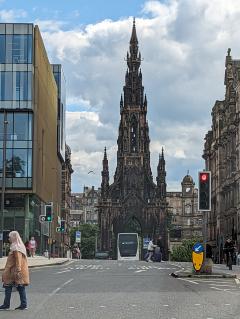 We reached Edinburgh in early afternoon and checked into the Mercure Edinburgh City Prince Street Hotel, which was a nice place in walking distance of the Royal Mile, but with awful parking. Like most hotels in crowded old European cities they have no parking of their own, they have a deal with a "nearby" parking garage. In this case it was a half a mile away through busy streets. There is no dedicated place to unload baggage, but you can try to park for a little while on narrow Rose Street behind the hotel, until you get chased away. The hotel also has no porters, but a woman from the front desk did her best to help. They also have no baggage carts, so she, Lorna, and Melissa woman-handled the bags because I was getting evicted by a very large, humorless Scotsman in a delivery truck.
We reached Edinburgh in early afternoon and checked into the Mercure Edinburgh City Prince Street Hotel, which was a nice place in walking distance of the Royal Mile, but with awful parking. Like most hotels in crowded old European cities they have no parking of their own, they have a deal with a "nearby" parking garage. In this case it was a half a mile away through busy streets. There is no dedicated place to unload baggage, but you can try to park for a little while on narrow Rose Street behind the hotel, until you get chased away. The hotel also has no porters, but a woman from the front desk did her best to help. They also have no baggage carts, so she, Lorna, and Melissa woman-handled the bags because I was getting evicted by a very large, humorless Scotsman in a delivery truck.
But we were in Edinburgh, a city famous for arts and architecture, history and literature, so we didn't let the idiotic inefficiencies of the Mecure Hotel spoil our prospects for a day of exploring!
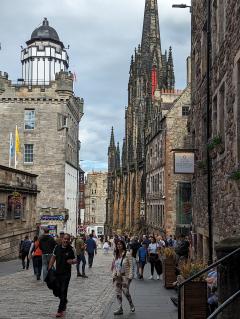 The most famous part of Edinburgh is the Royal Mile, a long stretch of shopping, dining, historic sites and monuments that extends from Edinburgh Castle at the top of the hill, down High Street for a mile to Holyrood Palace. It's not exactly closed to traffic, but like Provincetown's Commercial Street in July, most vehicles find other ways to get where they are going.
The most famous part of Edinburgh is the Royal Mile, a long stretch of shopping, dining, historic sites and monuments that extends from Edinburgh Castle at the top of the hill, down High Street for a mile to Holyrood Palace. It's not exactly closed to traffic, but like Provincetown's Commercial Street in July, most vehicles find other ways to get where they are going.
Somewhere on the Royal Mile, Lorna had found Clarinda's Tea Room on that 1991 trip. Clarinda is an uncommon name, but it was the name of one of her grandmothers, and so she had a goal of finding that again, and having tea there, if possible. Melissa was interested in the history and the famous writers, and they both wanted to shop until they couldn't anymore. We made a plan to meet for dinner at 8:00 (remember that it stays light forever on summer days at that latitude) and then they started exploring the shops while I made good on a promise to an old friend.
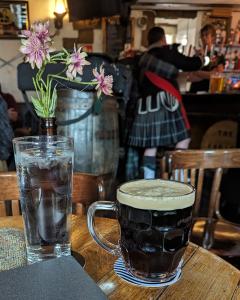 My friend Ralph has spent a lot of time in Edinburgh, and he told me about many places to see. Of all of them, he said the one not to miss was to get a pint at The Ensign Ewart, an ancient pub full of character and characters. I fulfilled my solemn obligation with appropriate decorum, even after my pint of Auld Reekie was very nearly toppled by the tippler in the kilt in the photo.
My friend Ralph has spent a lot of time in Edinburgh, and he told me about many places to see. Of all of them, he said the one not to miss was to get a pint at The Ensign Ewart, an ancient pub full of character and characters. I fulfilled my solemn obligation with appropriate decorum, even after my pint of Auld Reekie was very nearly toppled by the tippler in the kilt in the photo.
It is my habit on these vacations to set aside at least one quiet afternoon alone to catch up on all my notes and get them in proper order so that when I return I can write it up just like this. It has the added benefit of helping to fix all the best memories into my long-term memory as well as having them written down. I had done that once already on the Queen Mary 2, but we had accomplished and experienced a lot in England and in Scotland so far so I needed the afternoon, and one additional pint, to catch up.
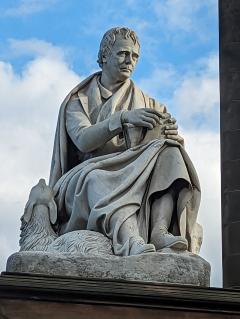 Edinburgh and its celebrated university were home to or a working base for a number of famous writers, philosophers, and scientists, including philosophers Adam Smith and David Hume, scientists James Watt, Alexander Graham Bell, James Clerk Maxwell, and Alexander Fleming, and writers Sir Walter Scott, Sir Arthur Conan Doyle, Robert Louis Stevenson, James Barrie, and of course the great poet Robert Burns.
Edinburgh and its celebrated university were home to or a working base for a number of famous writers, philosophers, and scientists, including philosophers Adam Smith and David Hume, scientists James Watt, Alexander Graham Bell, James Clerk Maxwell, and Alexander Fleming, and writers Sir Walter Scott, Sir Arthur Conan Doyle, Robert Louis Stevenson, James Barrie, and of course the great poet Robert Burns.
Sir Walter Scott, the subject of this monument, deserves particular attention. In the early 19th Century he was one of the English-speaking world's most popular authors, and he more or less invented the genre of historical fiction with Ivanhoe. His Waverly series of novels, including Waverly, Rob Roy, and The Bride of Lammermoor, became sensations that did much to put Scotland into the minds of readers everywhere. The Bride of Lammermoor became the basis for the opera Lucia di Lammermoor by Gaetano Donizetti, which continues to be performed frequently in the best opera houses in the world. It's not an exaggeration to say that Sir Walter Scott defined Scotland in the popular imagination for millions of people.
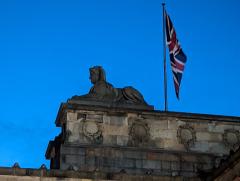 When it was time for supper, we convened at The Witchery, named for a nearby historical monument to the memory of the thousands of women unjustly burnt as witches in past centuries. It was an excellent dinner in a very nice place in the shadow of Edinburgh Castle and a fine way to end a busy day before the short walk down the hill through winding ancient alleys back to our hotel. Lorna had found Clarinda's, still open after 30 years, and so we made a plan to have breakfast there the next morning before heading south on our return to England.
When it was time for supper, we convened at The Witchery, named for a nearby historical monument to the memory of the thousands of women unjustly burnt as witches in past centuries. It was an excellent dinner in a very nice place in the shadow of Edinburgh Castle and a fine way to end a busy day before the short walk down the hill through winding ancient alleys back to our hotel. Lorna had found Clarinda's, still open after 30 years, and so we made a plan to have breakfast there the next morning before heading south on our return to England.
